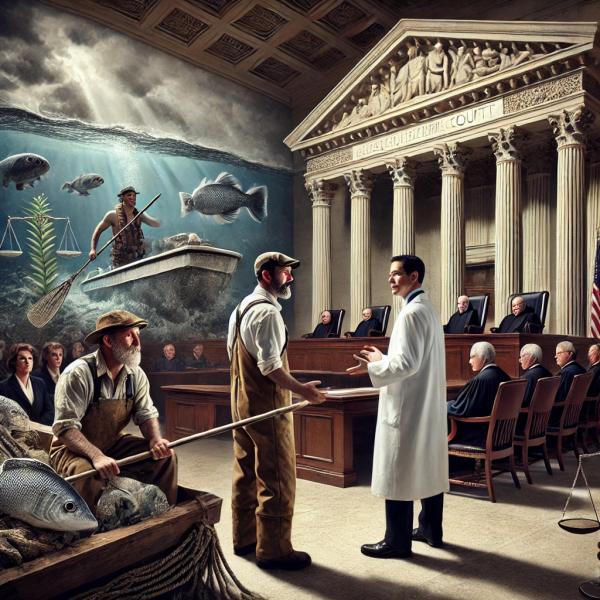
A modified version of this article appears in Harvard’s Bill of Health, which you can find here. It was written before the Supreme Court decision on the Chevron Deference.
Legal pundits long predicted the Chevron doctrine's demise (or at least substantial enfeeblement). Until recently, that case afforded substantial judicial deference to decisions made by administrative agencies if a statutory provision under its purview was ambiguous. Two cases before the Supreme Court challenged the agency's interpretation regarding funding statutorily required monitoring on fishing boats, which aimed to promote ocean eco-sustainability. But paying the monitors inured to the detriment of the fishing industry. And their presence took up valuable space on the fishing boats.
Chevron held that “a government agency must conform to any clear legislative statements when interpreting and applying a law, but courts will give the agency deference in ambiguous situations as long as its interpretation is reasonable.” Current predictions from court watchers are dire. How will agencies relying on scientific expertise, like the FDA, CDC, and NOAA, without Chevron deference, function? And does it matter?
The cases currently before the Supreme Court are portrayed as legal dilemmas, begging for legal refinement, realignment, or repudiation at the expense of deference to this agency's expertise.
Hogwash. This is all about politics — and politics under the cloak of judicial robes, at that.
Acknowledging this elephant in the room might be the best path to safeguarding regulations affecting public health and safety that lie under various agencies’ aegis.
Supreme Court-watchers envision doomsday vignettes, worrying that the FDA (and the other 436 federal agencies grunting out administration of the federal government) will be hamstrung as courts second-guess technical or scientific agency decisions made with the input of a cadre of scientific professionals and resources. Indeed, FDA Commissioner Robert Califf appears to be on nail-biting watch.
Nevertheless, while warranted, the agita regarding Chevron’s impact on the FDA (and CDC) might be a bit overstated.
True, courts have recently trampled public health directives issued by federal agencies or local and state boards of health, warranting worry — even without limiting Chevron. In Roman Catholic Diocese v. Cuomo, the Supreme Court (swinging religiously/Conservative with the addition of Justice Amy Coney Barrett) ruled that Freedom of Religion trumps public health, rejecting the time-honored precepts of Jacobson v. Massachusetts, usurping the State’s police powers, and countermanding similar directives issued only months earlier (prior to Justice Barrett’s ascension to the bench).
In Florida, local Boards of Health and School Districts determined that masking in schools was important. Yet, an administrative court sustained a flawed Gubernatorial Executive Order, which penalized schools that implemented mask requirements. The administrative law judge claimed he had the power to determine the propriety of masking during an epidemic, finding that “the rule merely codified a ministerial function, overruling practicing medical experts and making his own scientific determinations. Perversely, the Governor relied on a much-maligned State Surgeon General to back up his anti-mask order, yet this “science-based” policy was never subjected to judicial scrutiny.
Politics as Predictor
The cases before the Court involved fishing sustainability and profits to the fisheries. But a focus on the scientific/technical prowess of federal agencies to justify Chevron deference, sadly, might be “a red herring.” In other words, it’s all about money — under the guise of powers of statutory interpretation. Stated otherwise, it’s all about politics.
Interestingly, in its early days, Chevron, decided in 1984 during the Reagan years, was embraced by conservatives. Justice Scalia himself proclaimed his approval at a talk before Duke University. Commentators agreed that “Chevron … allowed the Environmental Protection Agency … to interpret the Clean Air Act in favor of business. At the time, the decision … was considered a stinging loss for environmentalists,” although it was recognized that the agency would remain free in a new administration to change its mind about what the statute means.
That is exactly what is happening – and now, the Conservatives don’t like it.
The Rashomon Effect: When Politics Hijack Law
In 1950 the Japanese film “Roshomon” depicted a particular story from the different perspectives of three characters. The term has entered our lexicon to refer to situations where different people see the same thing and give different, even contradictory, explanations. So it is here.
During the Biden administration, Chevron opponents claimed that agency decisions were politically motivated, while judicial determinations are made by “independent judges.” It’s not a new argument. Justice Kavanaugh noted in an analogous case, Kisor v. Wilkie (which discusses agency interpretation of agency rules of its own making), that “unqualified command requires the court to determine legal questions… by its own lights, not by those of political appointees or bureaucrats who may even be self-interested litigants in the case at hand.”
Kavanaugh’s position forms the same rationale for the contrary opinion by Justice Kagan: “Agencies (again unlike courts) have political accountability, because they are subject to the supervision of the President, who in turn answers to the public.” Justice Breyer argued that rejecting agency deference “sounds like the greatest judicial power grab since Marbury versus Madison.”
Indeed, the plaintiffs argue that “government” is unduly favored by an agency interpretation, justifying judicial intervention. However, this “government” is the one we voted into power — whose job is to safeguard the populace (which changes over time). The plaintiffs make their (political) focus crystal clear, arguing that “Chevron’s primary victim is the citizenry because the approach “literally gives the tie to the regulators in every case.”
So, who were the “victims” in the cases before the Court? It’s not the citizenry. It’s the fishing business. In masking — or vaccine mandates — or drug cases, the “victims” have been “libertarians” or big pharma or other members of industry. And the “nefarious” regulators (acting on behalf of the government)? They are the ones championing public health.
In fact, courts have been disregarding Chevron for a while– often to the detriment of public health and favoring individual choice, so we shouldn’t see much change after the advent of the Loper Bright Cases. When COVID-19 initially struck, the CDC sought to impose a mask mandate on vehicles engaged in interstate commerce or in platforms leading to that activity. According to the court in Health Defense v. Biden, the power of the CDC turned on the meaning of the word “sanitation,” as used in the Public Health Act of 1944. The clause under interpretation provides that:
“The [CDC]… is authorized to make and enforce such regulations… necessary to prevent the introduction, transmission, or spread of communicable diseases … from one State or possession into any other State or possession. For purposes of carrying out and enforcing such regulations, the [CDC] may provide for such inspection, fumigation, disinfection, sanitation .., and other measures, as in his judgment may be necessary.”
The issue was the meaning of “sanitation .”The government claimed this power included masking. The judge, relying on general use when the statute was enacted, said sanitation meant cleaning and maintaining cleanliness. As any “sanitarian” [aka public health officer] will attest, the word, in the public health arena, includes fostering conditions that minimize disease spread, along the lines of John Snow removing the pump from the Broad Street well during the 1854 cholera epidemic.
If any case triggered Chevron and required deference to agency interpretation, this one should have been it. Nevertheless, the judge brushed Chevron aside and denied the CDC’s powers to order masking in interstate commerce.
It doesn’t seem to me that things could get much worse, the Loper Bright decision notwithstanding.
Be Careful What You Wish For
Now that Mr. Trump will be taking office, populating the agencies with his brand of Republicans interpreting statutes to their liking, the new ruling will allow courts to overturn their rulings. Too bad for the R’s.
But while our Supreme Court denuded the National Marine Fishery Service of Chevron protection, my view is the case’s trickle-down effect will find lower courts limiting their decisions to issues that are legal, political, or economic – i.e., issues within the knowledge base of a non-scientifically inclined court that don’t require agency-expert input. Of course, there’s always the exception, like Judge Mizelle in the Health Defense Fund case. We still must be vigilant, being mindful of the domino affect– and the impact on public health. I expect to see amicus briefs proliferating.
In case anyone wondered about the political gamesmanship involved in Loper Bright rather than forging solutions, just consider: the parties could have suggested camera drones be used instead of monitors- the amount of money spent in litigating the case would more than have covered their cost, and they don’t even take up fishing boat space.



